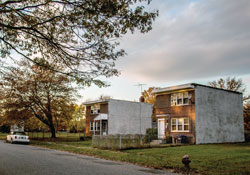Did town show disparate-impact bias in taking over buildings?
A housing discrimination case from New Jersey could lead to one of the biggest decisions of the U.S. Supreme Court’s term. On the other hand, if it proceeds like another recent fair housing case, it could end up a dud.
The justices granted review of Mount Holly v. Mount Holly Gardens Citizens in Action Inc. at the end of their last term. It is slated for argument Dec. 4 on the question of whether disparate-impact claims of discrimination may be brought under the federal Fair Housing Act of 1968.

Few houses remain in Mount Holly Gardens, which is being replaced by a new development that is the subject of a fair housing case coming before the Supreme Court this month. Photo by Colin M. Lenton.
Two terms ago, the Supreme Court was slated to take up that question in a case involving claims of disparate-impact bias in the city’s regulation of rental properties in St. Paul, Minn. The question is significant not just for housing issues at the building and city levels, but for banks, mortgage companies, the insurance industry and other entities covered by the fair housing law.
Fearing that the conservative majority on the high court might find that the Fair Housing Act does not permit disparate-impact claims, President Barack Obama’s administration and civil rights groups convinced the city of St. Paul to settle the case. As the ABA Journal was going to press in November, a tentative settlement was reported in the New Jersey case but had not been finalized. Nevertheless, all sides had already briefed the contentious case.
“This case deals with something we all have to have, which is housing,” says David C. Frederick, the Washington, D.C.-based Supreme Court specialist who will argue for a group of citizens of the Mount Holly Gardens complex. “There are broad or narrow ways for the court to decide this case.”
At issue are claims that the efforts of the township of Mount Holly, population 9,500, to redevelop a deteriorating neighborhood of 329 brick row houses had a disparate impact on the mostly black and Hispanic residents there.
Click here to read the rest of “When a House Is Not a Home” from the December issue of the ABA Journal.



